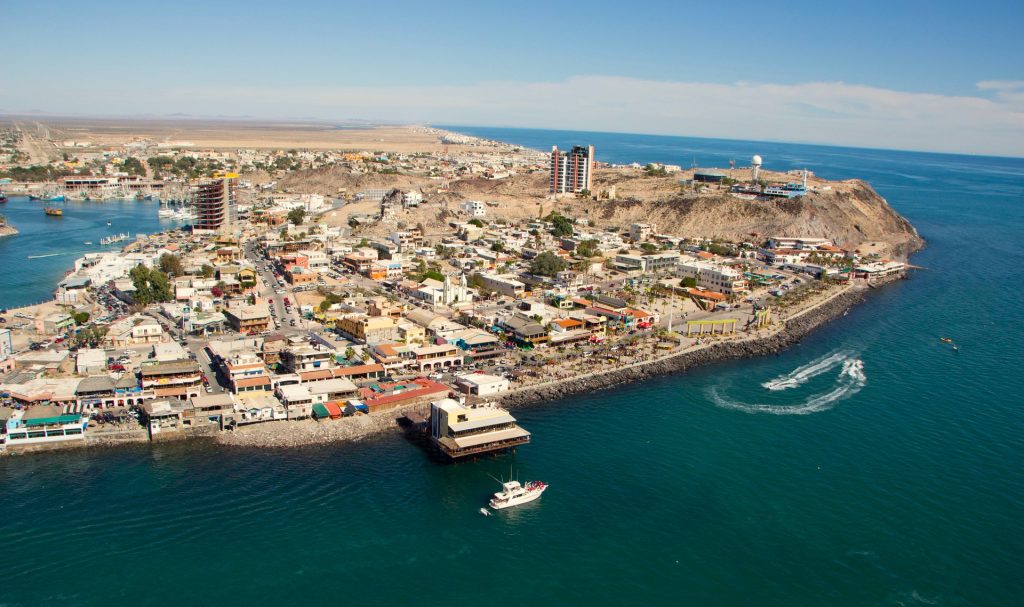
Looks can be deceiving. That is if you don’t know better. So, if you see the city of Puerto Peñasco on a map, it is easy to overlook. You might even miss it if focus on its nickname, “Rocky Point.” However, we can quickly fix that stuff.
Stay here and explore. You will surely discover why people keep finding this hidden Mexico beach paradise.
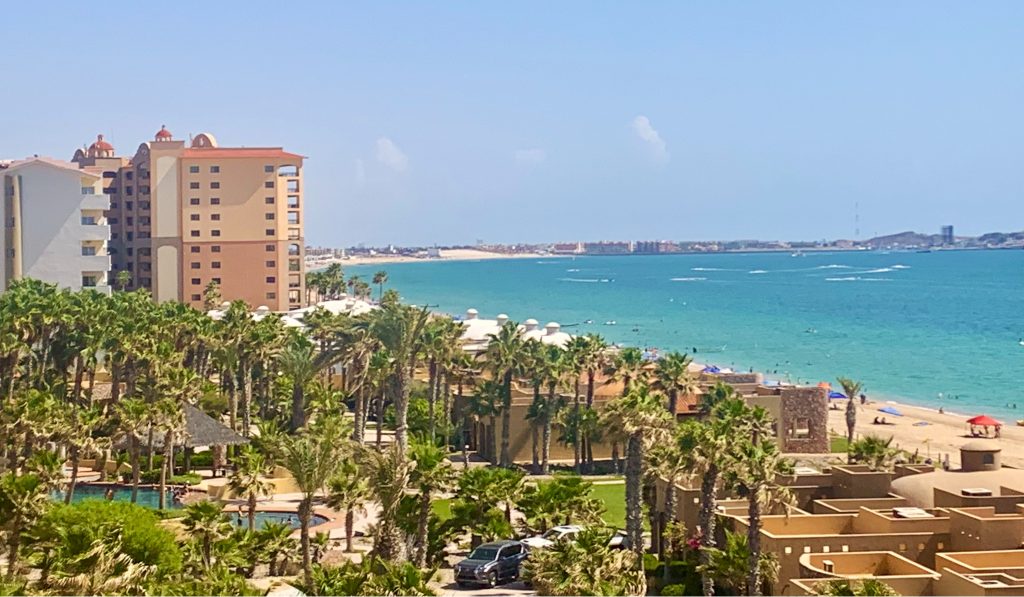
The past 25 years have produced the greatest growth spurt. Continued success has come through commercial development. The real estate market has been led by interest in luxury beachfront living. And increased popularity with new and returning tourists boosts the local economy.
Despite sustained growth, the city is by no means a gold rush scenario. You are from being late. Rocky Point Mexico still has a long runway of potential. And this goes well beyond expanding the city’s airport which has always had only a minimal impact.
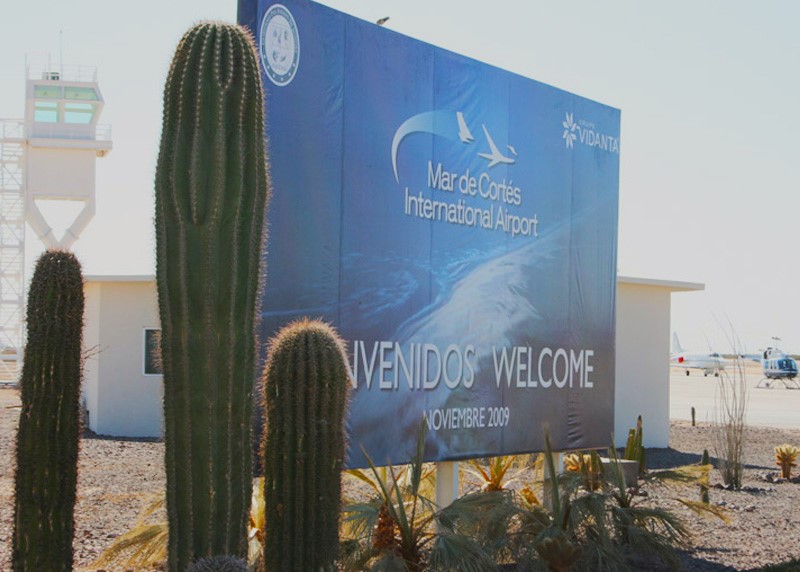
Puerto Peñasco History
History states it was back in 1826, that the English influence on Puerto Peñasco began. Credit (or blame) goes to Robert William Hale Hardy. He was a retired sailor from the British Royal Navy. Hardy and his boys came to this area of the sea in search of pearls and precious metals.
The Brit named the area “Rocky Point” because of the terrain by the port. And the word spread. The port location was identified on marine maps as Rocky Point. It stayed that way for more than a hundred years until Mexico President Lázaro Cárdenas changed the name to “Puerto Punta Peñasco.”
But let’s face it. Saying 3 consecutive P’s in a row can be interesting, especially if tequila is involved.
So, the people spoke. This meant the new name got shortened unofficially. Most simply punted on the word “punta” because they liked Puerto Peñasco better. Currently, many Mexicans, Americans, and Canadians use Rocky Point which is even shorter and easier.
The city was incorporated in 1952. But it is really in the past 25 years that more people have made it their business to reside here. This was proven by the 2020 census which registered a population of 62,689. That growth made it the 8th largest municipality in the state of Sonora. The local population has more than doubled since the 2000 census.
Rocky Point Mexico Today
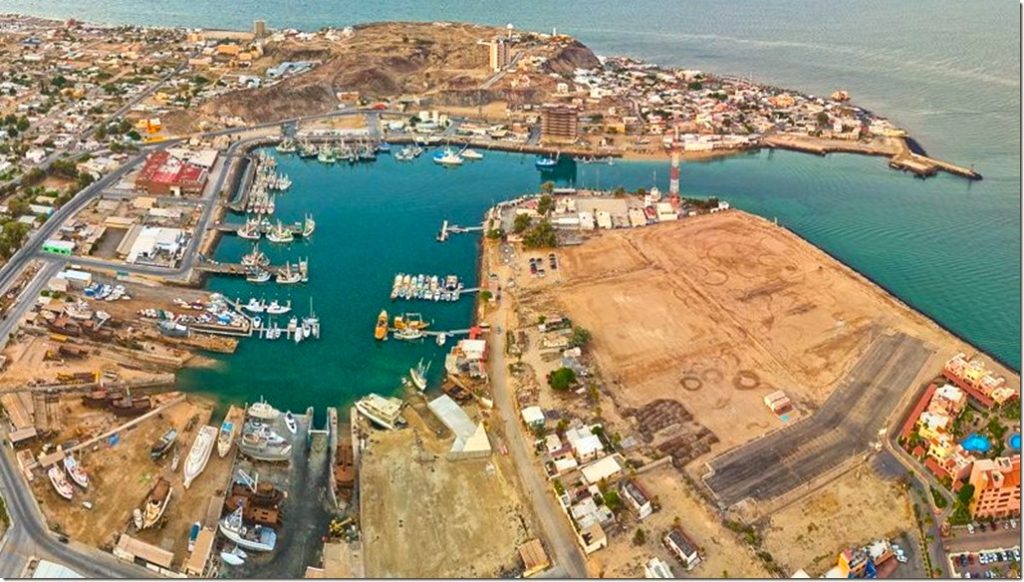
Credit for today’s Rocky Point goes to its commercial and residential real estate development. In the photo above you see the old port area is in the same location. To its west is the popular Sandy Beach. It features a few miles of luxurious, beachfront high-rise resorts such as ours at the Sonoran Sun. Most of the Rocky Point Condos for rent are along Sandy Beach.
Left of the port and behind it inland is the downtown area where city hall and other municipal offices are located. Along the waterfront is the popular commercial stretch known as the malecon. This is a major gathering area with restaurants, bars, and souvenir shops.
Above is the only real elevated section of Puerto Peñasco which can easily be seen by those at sea as the “Rocky Point” everyone knows. This steep area is known as Whale Hill.

East Side of Town
Heading east from downtown and the malecon provides more variety. First, is the other popular beach area known as El Mirador. This area is a mix of residential and commercial real estate. Here you will find motels, bars, After El Mirador, it becomes more remote heading east which means you will notice less convenience and services.
Another 5 miles east takes you to the most exclusive section of Rocky Point Mexico. It is known as Las Conchas. This is a community of mostly large, high-priced private homes. Despite its exclusivity, Las Conchas is a fairly compact area a few miles long. Naturally, the most expensive real estate is the homes on the beach. Meanwhile, the rest of the homes can be found a few blocks inland. All roads in Las Conchas are unpaved. So, like other parts of town, you can expect flooding and muddy conditions when it rains.
Still further east another 15 miles is the area known as Playa Encanto. This is a less developed section which is basically residential including private beaches. There are also a few condominium resorts and new road development out this way heading toward Caborca.
West Side of Town
Crossing the city to the west side is the other exclusive residential community known as Cholla Bay. This is another hilly area with some large and higher priced homes, especially those with beautiful views of the bay below. It too features non-paved roads. Since this area faces west, it offers great sunset experiences year-round.
Just north of the Cholla Bay neighborhood is a newly developed community called, Islas Del Mar.
Puerto Penasco: Mexico’s “Other” NW Beach
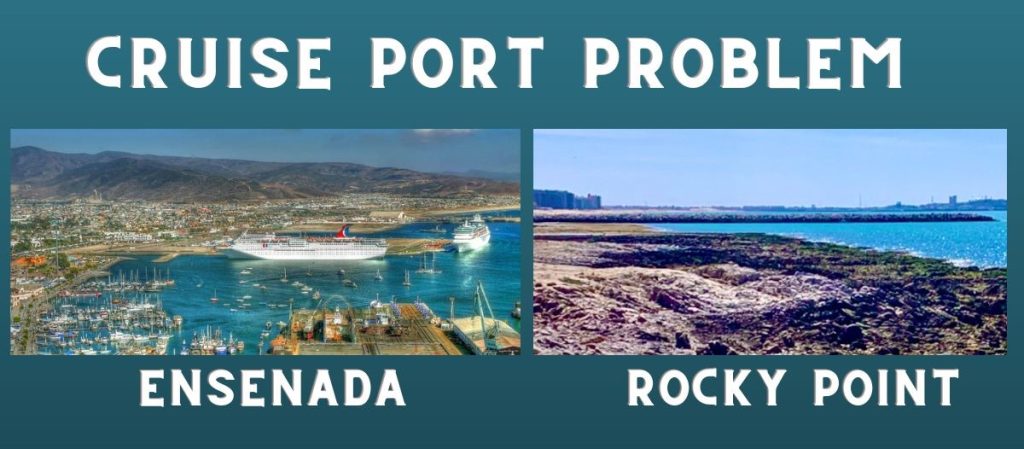
The city of Puerto Peñasco is in the northwest part of the Mexican state of Sonora. In turn, you will find Sonora is in the northwest part of the country. And yes, this area of Sonora is part of the massive Sonoran Desert. The land is considered part of the smaller Altar Desert as well.
Mexico’s most popular beaches are much further south. Meanwhile, Ensenada in Baja California is the best known in the northwest. It is more than three times the population of Rocky Point. And being over 300 miles to the west, it directly faces the Pacific Ocean. Being a popular cruise ship port of call doesn’t hurt Ensenada either. And if that isn’t enough of a leg up, Lyle Lovett hasn’t yet done a record about Puerto Peñasco.
The sad truth is the cruise port in Rocky Point sunk when tens of millions in funding vanished. And today, there remain financial as well as logistical challenges must be overcome to attract cruise ships. So, if you are looking to take a cruise, there are plenty of choices. On the other hand, whenever you are up for a fun and affordable Mexican beach getaway, Puerto Peñasco is waiting. And by doing this, you get to be the captain of your travel itinerary.
Rocky Point Road Tripping
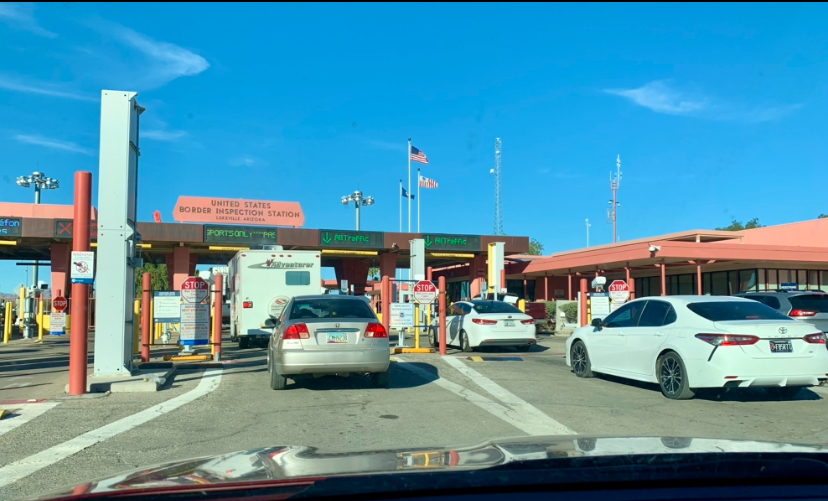
Road trips drive Rocky Point tourism.
The location is a reachable and convenient escape for Americans seeking a taste of Mexico. Because of this, most visitors enjoy easier and less expensive getaways than going to other beach destinations in the U.S. and Mexico. There are 2 main reasons driving the Rocky Point Road Tripping advantage:
2 Main “Drivers”
1. Everything here costs less than other popular American and Mexican beach destinations. (Take that Ensenada). This includes the price of hotel stays, meals, shopping, professional services, activities, etc.
2. The Mar de Cortés International Airport in Puerto Peñasco is quite small. It is the first privately funded airport in Mexico. But there are no commercial flights internationally. Meanwhile, the airport only recently got another chance at regional direct flights. Calafia Airlines now offers limited service between Puerto Peñasco and the Baja California cities of Tijuana, Loreto, and La Paz. Until the airport becomes relevant, driving tourists will drive the local economy.
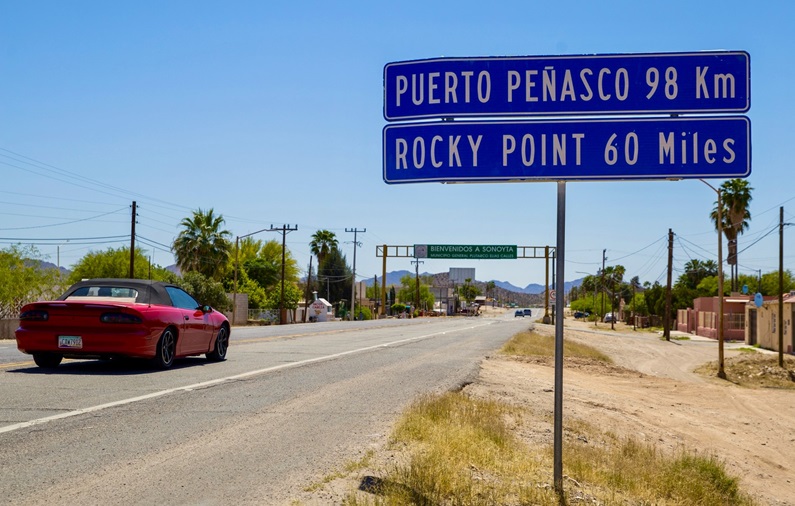
Other Signs Lead to Puerto Peñasco
A. Open Highways. People in the western United States are more open to road trips. Perhaps it is part of the mindset because the landscape is wide open. Less stops and traffic congestion mean less stress.
B. GPS technology takes you right there and tells you everything you need to know on the way. Plus, Sonora has road signs in English to help if you don’t speak the native language of Spanish.
C. Flexible Travel. Hopping in the car or SUV for Rocky Point road trips gives you the power to make and change decisions. For instance, you can stay an extra day or at least a few hours without airline penalties. You travel only with the people you choose. No being stuck with strangers.
These reasons mentioned here and others help to explain why Americans visit even when they reside near beaches in Southern California. Some from Las Vegas find the 8- to 9-hour drive their best beach bet. And many Rocky Point visitors think nothing of the 9- or 10-hour road trips from El Paso, Texas. Yes, even for just a great weekend at the beach.
And we must not forget our Canadian friends. Many of them make much longer seasonal drives or they fly to the U.S. and drive. Whatever it takes to flee the cold of The Great White North. You certainly can’t blame them for preferring sand between their toes instead of snow.
Puerto Peñasco: Close with Arizona
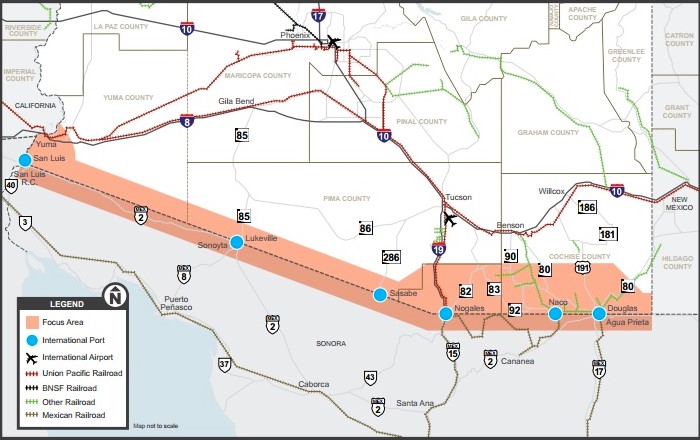
Arizona is the closest state to Rocky Point. Most Arizonans would still drive to Puerto Peñasco even if the Mar de Cortés International Airport was a viable option. At Lukeville, its southern border with Sonoyta, Sonora, is only about 60 miles away. (Based on how some anxious folks drive that makes it about a 30-minute ride). Nonetheless, with good reason, Puerto Peñasco is often referred to as “Arizona’s Beach.” Arizona residents have a very similar road trip from the major metropolitan areas of Phoenix and Tucson.
Despite being on different sides of the challenged border, the two states are neighborly. They work together. This is especially because of tourism interests.
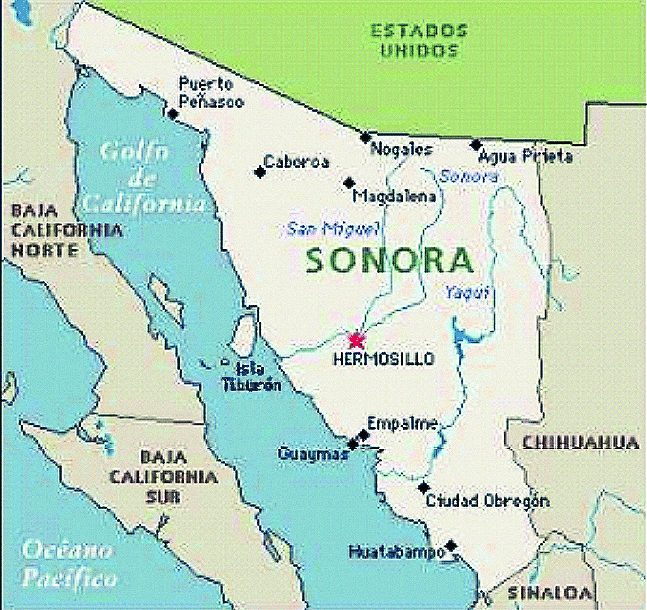
Meanwhile, the large neighboring Mexican states of Baja California and Chihuahua are slightly less than 150 miles from Rocky Point. And much further down the Gulf of California eastern shores, the state of Sinaloa is some 550 miles to the south.
2 State Surprises
The northwest Sonora location of Puerto Peñasco offers surprises geographically with 2 other states.
In the U.S. Much of the Lone Star State of Texas actually sits further south than Rocky Point Mexico. Go ahead. Draw a straight line across. You will see Puerto Peñasco is northwest of Texas’ capital city of Austin. You can add the big cities of San Antonio and Houston, and go all the area way down to Brownsville, Texas.
NOTE: This is why Rocky Point is the go-to beach destination for many who do not wish to travel deep into Mexico.
In Mexico. The area of Sonora where Puerto Peñasco is located is a unique strip of land. It is the only physical connection between Baja California and the rest of Mexico. And on the many clear days in Rocky Point, you can see Baja in the distance. Some of the best views are by looking west from the Sonoran Sun Resort condo balconies in the east tower.
Life On the Sea of Cortez / Gulf of California
Being seaside is everything in tourism related geography. So, most importantly of all its attributes, Puerto Peñasco sits on the northern shores of the Sea of Cortez. To keep with the two-name thing, the large body of water is also known as the Gulf of California. And like the dual names it serves a dual function. The sea flows into or out of the Pacific Ocean. Take your pick.
The Sea of Cortez is more than 700 miles long and up to 150 miles wide. And because it has all the makings of an ocean, many people frequently confuse it as such. It has salt water, waves, changing tides, fascinating sea life, and of course, beautiful beaches along its east, west, and north shores.
Sea Life
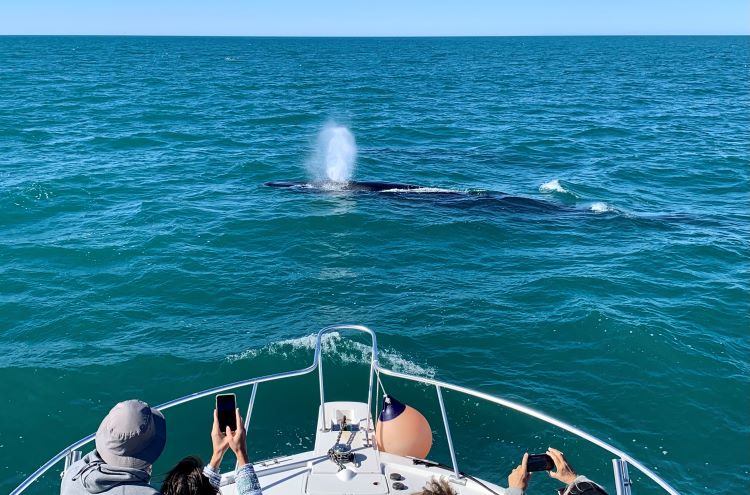
Whales migrate every winter from northern cold waters to the Gulf of California. They do their version of long drives to Rocky Point because of two all-important fact of life journeys. Mainly, the whales travel to these parts to give birth to baby whales and to reproduce. Whale watching has become an exciting annual tourist attraction to begin each new year. People who want to catch a glimpse of these awe-inspiring giants of the sea usually have the best chances from mid-January to mid-March.
Meanwhile, friendly dolphins call the gulf waters their home year-round. And they gladly share it by acting as local ambassadors for Puerto Peñasco. These playful creatures can be spotted up and down the beaches in town. For instance, you will often see them from your balcony when renting Sonoran Sun condos. Perhaps dolphins will get your attention while you are at a local watering hole like Margarita Mermaids or the Pitaya Bar enjoying a beverage. Or best of all, you could have an up close and personal encounter while you are in a boat, kayak, or on a paddleboard.

As one would expect being on the sea, fishing is a way of life. It remains an important industry in Rocky Point. However, the most popular seafood delight is shrimp. One quick look around town and you will see. Shrimp or prawn is the star and the catch of the day.
The waters off Puerto Peñasco have long been plentiful. It has been that way for commercial fishermen and tourists. Fishing here you might commonly catch triggerfish, mackerel, grouper, and snapper.
Naturally, “overfishing” became a problem. It was partly because of this in the 1990s when the city shifted toward promoting tourism instead. The top priority of generating tourism to boost the local economy remains firmly in place today.
Puerto Peñasco Weather
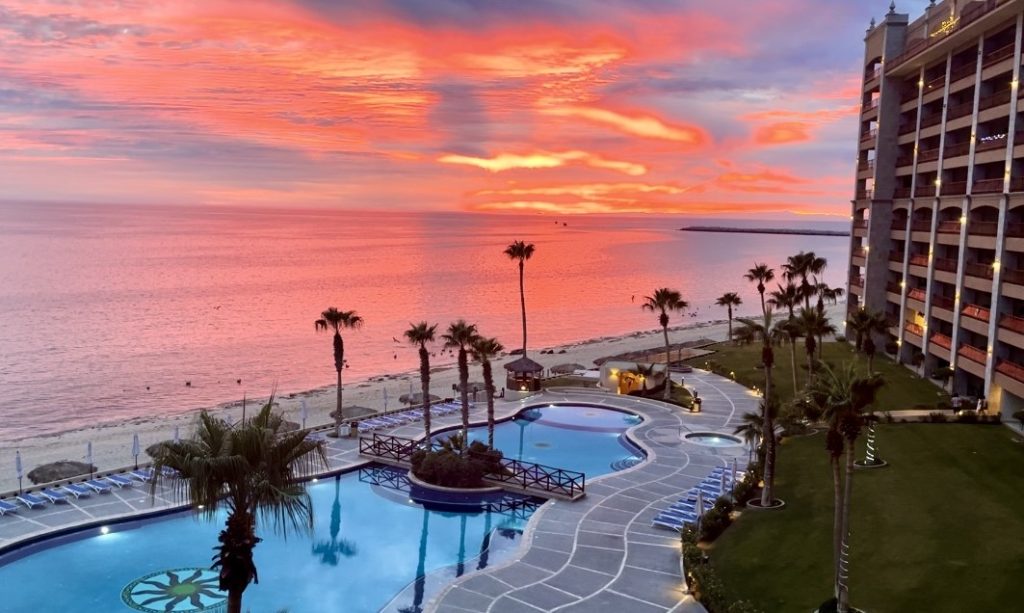
The climate here is much more than a fair-weather friend to Puerto Peñasco. For it to be a popular beach getaway, you must accommodate the wishes of tourists wanting a suntan. They won’t be happy with common cloudy or rainy conditions. The good news is Rocky Point Mexico averages well over 300 sunny days a year. That means 25 to 30 sunny days every month.
And should you like colorful sunrises and sunsets, keep in mind scenes like in the photo above. Some of the most spectacular displays over the Sea of Cortez occur when there are some clouds in the sky.
Being the southern edge of the Sonoran Desert, Puerto Peñasco features a hot and dry climate. However, you can also count on humidity because of being on the shores of the Gulf of California. The summer months are regularly hot and humid conditions. You will sweat more than you would in Arizona.
In general, you can usually expect the temperatures in Rocky Point to be slightly higher than Arizona during the winter months. And in turn, the temperatures are usually slightly lower in summer.
Puerto Peñasco offers great weather and affordability. Still, somehow this Mexican beachfront paradise has remained relatively unknown…except to those of us who love the place.

